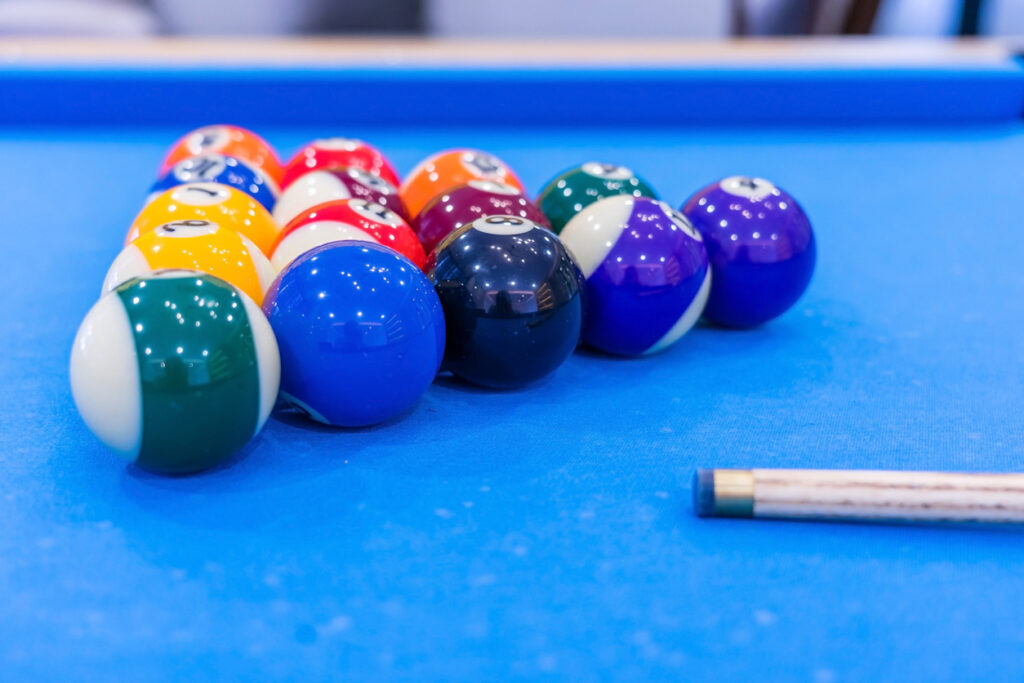Similar to pool, both are cue sports played on a table with cues and balls.
On the other hand, when it comes to the differences between Snooker and Pool or Billiards are significant in terms of equipment, rules, and gameplay.
The differences between Snooker and Pool or Billiards
- Table Size and Design: The tables are typically larger than pool tables. A standard snooker table is 12 feet by 6 feet, while pool tables vary in size with the most common being 9 feet by 4.5 feet for professional play. Snooker tables also have narrower pockets and a different arrangement of the pockets compared to pool tables.
- Balls: Snooker uses a total of 22 balls (15 reds, 6 colored balls, and a white cue ball), whereas pool typically uses 16 balls (7 solids, 7 stripes, a black 8-ball, and a cue ball in the most popular version, 8-ball). The balls in snooker are also smaller than those used in pool.
- Gameplay and Scoring: In this game, players score points for each ball potted according to its color, with the objective being to score more points than the opponent. A player must first pot a red ball and then pot a ball of a different color. Pool games, like 8-ball or 9-ball, have different objectives (such as potting all your group of balls then the 8-ball in 8-ball pool).
- Cues: Snooker cues are generally thinner and have a smaller tip compared to pool cues, as the balls in snooker are smaller and lighter.
- Tactical Play: It often involves more tactical play and precision due to the table size, smaller pockets, and the necessity of planning several shots ahead. Pool, while also requiring strategy and skill, tends to be faster-paced.
Despite these differences…
The skills required in both games have some overlap, such as ball control, precision, and strategic thinking. Many players enjoy both games, although they are distinct games within the world of cue sports.
The History of
Originating in the latter half of the 19th century, this makes it a relatively newer game compared to billiards, which has roots dating back several centuries.
Origin and Development of Snooker:
- Time Period: Invented in the 1870s.
- Place of Origin: The game originated among British Army officers stationed in India. It was particularly popular in the officers’ mess of the British regiments.
- Inventor: It was invented by Sir Neville Chamberlain (not to be confused with the British Prime Minister of the same name from a later period). He was a lieutenant in the British Army.
- Evolution of the Game: The game was derived from earlier forms of billiards, primarily from a game known as “Black Pool,” which involved potting balls in a specific order. Chamberlain added additional colored balls to the existing game and devised a new set of rules, thus creating this game.
- Spread and Popularity: It gradually gained popularity in England, particularly after the return of the British officers from India. The first official set of rules was established in 1882. By the 20th century, snooker had become a popular game in the United Kingdom and later expanded its reach globally.
- Professionalization: The game saw a significant rise in professional competition throughout the 20th century. This was due to the establishment of tournaments like the World Snooker Championship, which first took place in 1927.
The differences between Snooker and Pool or Billiards
Billiards (or more precisely, carom billiards) dates back to the 15th century in Europe. It started as an outdoor game similar to croquet and transitioned to an indoor table game.
The version of billiards most similar to snooker, known as English billiards, developed into its modern form in the 18th and 19th centuries. This predates the invention of snooker.
Thus, while it is a younger game than billiards, it shares a common lineage. The game has evolved to have its unique place in the world of cue sports.

